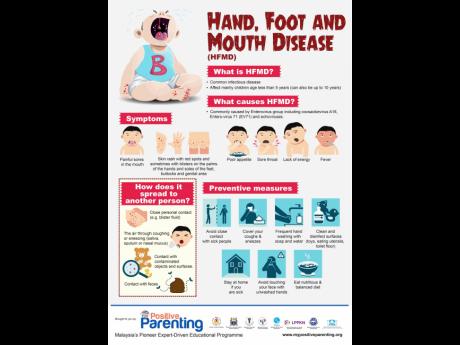Good work! - Jamaica must now maintain its prevention, eradication of infectious diseases
The Americas have been officially declared measles-free. The first of the six World Health Organization (WHO) regions to be designated completely free from endemic transmission of the disease.
The historic announcement was made by the International Expert Committee for Documenting and Verifying Measles, Rubella, and Congenital Rubella Syndrome Elimination in the Americas at the 55th Directing Council of the Pan American Health Organization/World Health Organization (PAHO/WHO) in September.
Measles is a viral disease affecting mostly children, and though often mild, can cause severe health problems, including pneumonia, brain swelling, blindness, encephalitis, severe diarrhoea, ear infections, and even death.
Wiping out endemic measles transmission across the Americas ends a 22-year effort involving mass vaccination against measles, mumps and rubella. Measles is one of the most contagious diseases. It is transmitted by airborne droplets or via direct contact with secretions from the nose, mouth, and throat of infected individuals.
Measles is the fifth infectious disease which can be prevented by vaccination that has been eliminated from the Americas. The eradication of measles follows the regional eradication of smallpox (1971), poliomyelitis (1994), and rubella and congenital rubella syndrome (2015).
Malaria-free in '63
Shortly after gaining Independence, Jamaica was declared malaria-free in 1963. Malaria is caused by an amoeba-like protozoan transmitted by the Anopheles mosquito. A transmission cycle established by Dr Ronald Ross in 1897, working in India.
An aggressive vector-control programme in Jamaica over several years prior to 1963 led to the elimination of the disease here. A WHO-backed Malaria Eradication Programme was launched in 1957 and ran to 1963, the year of declared eradication. Dr Herbert Eldemire, the father of Professor Denise Eldemire-Shearer, was the minister of health when the disease was declared eradicated in Jamaica.
Older readers will remember the sprayman spraying a DDT solution from house to house and nailing a disc on the front door when done. DDT, which had been so effective in the malaria campaign, has been banned around the world, beginning in the United States in 1972, for being destructive to the environment. The detailing of the negative environmental impact of DDT by Rachel Carson in her 1962 book, Silent Spring, marks the genesis of the modern environmental mass movement.
Malaria is still endemic across the tropical Americas and much of the rest of the world, delivering 214 million new cases last year and causing 438,000 deaths.
In 2015, the global burden of malaria remained heavily concentrated in 15 countries, mainly in Africa. Together, these countries account for an estimated 80 per cent of global malaria cases and 78 per cent of deaths.
Within CARICOM, malaria is still endemically present in Belize and Guyana. And across the wider Caribbean in Haiti and the Dominican Republic. There are particularly high incidences in Columbia and Venezuela.
Smallpox is the first, and only, infectious disease to be declared totally eradicated on the planet. The Americas was designated smallpox-free in 1971. Smallpox is transmitted from person to person via infective droplets during close contact with infected symptomatic people.
The last known natural case of this viral infection which has been a scourge of humankind from time immemorial was in Somalia in 1977. The disease was declared eradicated in 1980 following a global immunisation campaign led by the World Health Organization.
The next infectious disease on the radar for global eradication is poliomyelitis, a viral infection which can cause paralysis. The WHO is a partner in the Global Polio Eradication Initiative, the largest private-public partnership for health, which has reduced polio by 99 per cent. The disease remains endemic in only three countries, Afghanistan, Nigeria and Pakistan. There were only 74 reported cases in 2015.
Cholera comeback
Cholera is now making a comeback in Haiti, following the battering of the country by Hurricane Matthew. The waterborne bacterial infection which manifests with severe diarrhoea resurfaced in that country after the 2010 earthquake, widely believed to have been brought in by UN peacekeepers.
Jamaica last saw cholera in the 1850s. There was a major outbreak in 1851, which is estimated to have killed a tenth of the population, around 40,000 people out of 400,000. Cholera is an Old World Disease with likely origins on the Indian sub-continent because of its prevalence in that region for centuries. It only appeared in the Americas in the 1830s during the second of seven cholera pandemics which have affected the world in the last 200 years. Jamaica was affected by the second and third pandemics, 1827-1835 and 1839-1856, and has not seen the disease since. Its long absence would leave the population particularly vulnerable without immunity, as was the case in Haiti in 2010. With modern treatment regimes, mortality from cholera is very low and many people who pick up the bacteria do not even develop symptoms. Prevention is better than cure and the best preventive measure against cholera is clean, treated water.
Jamaica has built up an enviable infectious diseases control and eradication public-health system which we must now maintain and improve to keep the bugs out or, at least, under control.
- Martin Henry is a university administrator. Email yourhealth@gleanerjm.com

